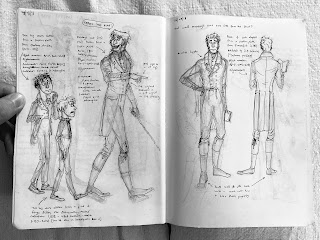Following on from the previous sketchbook, I was trying to do some kind of reconstruction of what might've happened during a few minutes one morning at Bowes Academy. (Time-lapse video here!)
Some views around the building. Entirely speculative, from viewpoints that I couldn't access in real life, and some have my imagined version of what missing parts of the building might have looked like.
 |
| Trying to work out what Charley wears, using extant garments and fashion plates in museum collections. |
 |
| Then Charley suddenly got cheerful? (I think he must've been hung over earlier) |
 |
| Probably the last time I did anything with the pump reconstruction. |
Also more visual notes, this time about the ophthalmia trials. This was just before I redesigned William's face! (He used to look different in my older work.)
 |
| According to Horatio Lloyd, who attended Bowes Academy in the early 1820s, William Shaw would play the flute to entertain boys who were unwell. In what other contexts might he have played it? What might other people have thought about it? (I keep forgetting about Lloyd's mention of the flute business - I haven't seen it anywhere else - scroll down this page to see it) |
 |
| Messing about with one of William's adverts, from the York Herald, 28 June 1834. |
A lot of this sketchbook is notes on lectures and books. Before I started the PhD, I emailed my university's History department asking them for book recommendations - they gave me some, and kindly invited me to join their HM5001 lectures on historiography, methodology, theory, etc., and that's where I picked up my love of that kind of thing. (Now when I see any mention of historians not wanting to engage with theory, or philosophy of history, or anything like that, I'm like "WHY?! It's FUN, you are missing out")
The next couple of spreads are about bringing some occult influences into my work, specifically using planetary correspondences (using the seven classical planets) to play with character design/ interpretation. For instance, Saturn is sometimes associated with time and death (I'm a historian, these are relevant), and also with melancholy, responsibility, practicality, austerity - all things I associate with my interpretation of William.

As with all these posts about my PhD sketchbooks, this is only a few pages from this particular book. For more sketchbooks, here's the list.














No comments:
Post a Comment